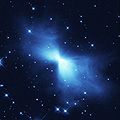Datei:Boomerang nebula.jpg

Originaldatei (1.590 × 1.590 Pixel, Dateigröße: 249 KB, MIME-Typ: image/jpeg)
Diese Datei stammt aus Wikimedia Commons und kann von anderen Projekten verwendet werden. Die Beschreibung von deren Dateibeschreibungsseite wird unten angezeigt.
Beschreibung
| BeschreibungBoomerang nebula.jpg |
The Boomerang Nebula is a young planetary nebula and the coldest object found in the Universe so far. The NASA/ESA Hubble Space Telescope image is yet another example of how Hubble's sharp eye reveals surprising details in celestial objects. This NASA/ESA Hubble Space Telescope image shows a young planetary nebula known (rather curiously) as the Boomerang Nebula. It is in the constellation of Centaurus, 5000 light-years from Earth. Planetary nebulae form around a bright, central star when it expels gas in the last stages of its life. The Boomerang Nebula is one of the Universe's peculiar places. In 1995, using the 15-metre Swedish ESO Submillimetre Telescope in Chile, astronomers Sahai and Nyman revealed that it is the coldest place in the Universe found so far. With a temperature of -272C, it is only 1 degree warmer than absolute zero (the lowest limit for all temperatures). Even the -270C background glow from the Big Bang is warmer than this nebula. It is the only object found so far that has a temperature lower than the background radiation. Keith Taylor and Mike Scarrott called it the Boomerang Nebula in 1980 after observing it with a large ground-based telescope in Australia. Unable to see the detail that only Hubble can reveal, the astronomers saw merely a slight asymmetry in the nebula's lobes suggesting a curved shape like a boomerang. The high-resolution Hubble images indicate that 'the Bow tie Nebula' would perhaps have been a better name. The Hubble telescope took this image in 1998. It shows faint arcs and ghostly filaments embedded within the diffuse gas of the nebula's smooth 'bow tie' lobes. The diffuse bow-tie shape of this nebula makes it quite different from other observed planetary nebulae, which normally have lobes that look more like 'bubbles' blown in the gas. However, the Boomerang Nebula is so young that it may not have had time to develop these structures. Why planetary nebulae have so many different shapes is still a mystery. The general bow-tie shape of the Boomerang appears to have been created by a very fierce 500 000 kilometre-per-hour wind blowing ultracold gas away from the dying central star. The star has been losing as much as one-thousandth of a solar mass of material per year for 1500 years. This is 10-100 times more than in other similar objects. The rapid expansion of the nebula has enabled it to become the coldest known region in the Universe. The image was exposed for 1000 seconds through a green-yellow filter. The light in the image comes from starlight from the central star reflected by dust particles. |
|||
| Datum | ||||
| Quelle | https://www.spacetelescope.org/images/heic0301a/ | |||
| Urheber | ESA/NASA | |||
| Genehmigung (Weiternutzung dieser Datei) |
|
Lizenz
| Public domainPublic domainfalsefalse |
| Diese Datei ist gemeinfrei (public domain), da sie von der NASA erstellt worden ist. Die NASA-Urheberrechtsrichtlinie besagt, dass „NASA-Material nicht durch Urheberrecht geschützt ist, wenn es nicht anders angegeben ist“. (NASA-Urheberrechtsrichtlinie-Seite oder JPL Image Use Policy). |  | |
 |
Warnung:
|
Kurzbeschreibungen
In dieser Datei abgebildete Objekte
Motiv
20. Februar 2003
image/jpeg
42c243802b26913bf892b86072843cbf5f84b05f
255.212 Byte
1.590 Pixel
1.590 Pixel
Dateiversionen
Klicke auf einen Zeitpunkt, um diese Version zu laden.
| Version vom | Vorschaubild | Maße | Benutzer | Kommentar | |
|---|---|---|---|---|---|
| aktuell | 15:29, 19. Mai 2007 |  | 1.590 × 1.590 (249 KB) | wikimediacommons>Pamputt | {{Information |Description= |Source= |Date= |Author= |Permission= |other_versions= }} |
Dateiverwendung
Die folgende Seite verwendet diese Datei:
Metadaten
Diese Datei enthält weitere Informationen, die in der Regel von der Digitalkamera oder dem verwendeten Scanner stammen. Durch nachträgliche Bearbeitung der Originaldatei können einige Details verändert worden sein.
| _error | 0 |
|---|